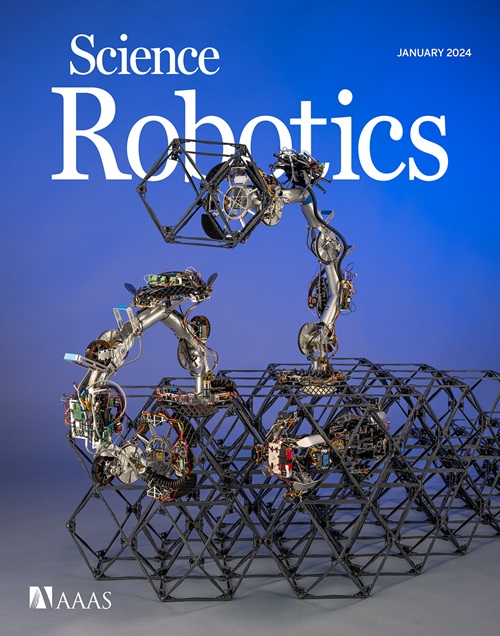Embodying soft robots with octopus-inspired hierarchical suction intelligence
IF 27.5
1区 计算机科学
Q1 ROBOTICS
引用次数: 0
Abstract
Octopuses exploit an efficient neuromuscular hierarchy to achieve complex dexterous body manipulation, integrating sensor-rich suckers, in-arm embodied computation, and centralized higher-level reasoning. Here, we take inspiration from the hierarchical intelligence of the octopus and demonstrate how, by exploiting the fluidic energy and information capacity of simple suction cups, soft computational elements, and soft actuators, we can mimic key aspects of the neuromuscular structure of the octopus in soft robotic systems. The presented suction intelligence works at two levels: By coupling suction flow with local fluidic circuitry, soft robots can achieve octopus-like low-level embodied intelligence, including gently grasping delicate objects, adaptive curling, and encapsulating objects of unknown geometries, and by decoding the pressure response from a suction cup, robots can achieve multimodal high-level perception, including contact detection, classification of an environmental medium and surface roughness, and prediction of an interactive pulling force. As in octopuses, suction intelligence executes most of its computation within lower-level local fluidic circuitries, and minimum information is transmitted to the high-level decision-making of the “brain.” This development provides insights into octopus-inspired machine intelligence through low-cost, simple, and easy-to-integrate methods. The presented suction intelligence can be readily integrated into fluidic-driven soft robots to enhance their intelligence and reduce their computational requirement and can be applied widely, from industrial object handling and robotic manufacturing to robot-assisted harvesting and interventional health care.体现软体机器人与章鱼启发的分层吸力智能
章鱼利用高效的神经肌肉层级来实现复杂灵巧的身体操纵,整合了传感器丰富的吸盘、臂内嵌入计算和集中的高级推理。在这里,我们从章鱼的分层智能中获得灵感,并演示如何通过利用简单吸盘的流体能量和信息容量,软计算元件和软执行器,我们可以在软机器人系统中模拟章鱼神经肌肉结构的关键方面。本文提出的吸力智能工作在两个层面:通过将吸力流与局部流体电路耦合,软体机器人可以实现类似章鱼的低级具身智能,包括轻轻地抓取精致物体、自适应卷曲和封装未知几何形状的物体;通过解码吸力杯的压力响应,机器人可以实现多模态高级感知,包括接触检测、环境介质和表面粗糙度的分类以及交互拉力的预测。就像章鱼一样,吸力智能在较低层次的局部流体电路中执行大部分计算,而向“大脑”的高层决策传递的信息最少。这一发展通过低成本、简单和易于集成的方法为章鱼启发的机器智能提供了见解。所提出的吸力智能可以很容易地集成到流体驱动的软机器人中,以提高它们的智能和减少它们的计算量,可以广泛应用于工业物体处理和机器人制造,机器人辅助采收和介入医疗等领域。
本文章由计算机程序翻译,如有差异,请以英文原文为准。
求助全文
约1分钟内获得全文
求助全文
来源期刊

Science Robotics
Mathematics-Control and Optimization
CiteScore
30.60
自引率
2.80%
发文量
83
期刊介绍:
Science Robotics publishes original, peer-reviewed, science- or engineering-based research articles that advance the field of robotics. The journal also features editor-commissioned Reviews. An international team of academic editors holds Science Robotics articles to the same high-quality standard that is the hallmark of the Science family of journals.
Sub-topics include: actuators, advanced materials, artificial Intelligence, autonomous vehicles, bio-inspired design, exoskeletons, fabrication, field robotics, human-robot interaction, humanoids, industrial robotics, kinematics, machine learning, material science, medical technology, motion planning and control, micro- and nano-robotics, multi-robot control, sensors, service robotics, social and ethical issues, soft robotics, and space, planetary and undersea exploration.
 求助内容:
求助内容: 应助结果提醒方式:
应助结果提醒方式:


